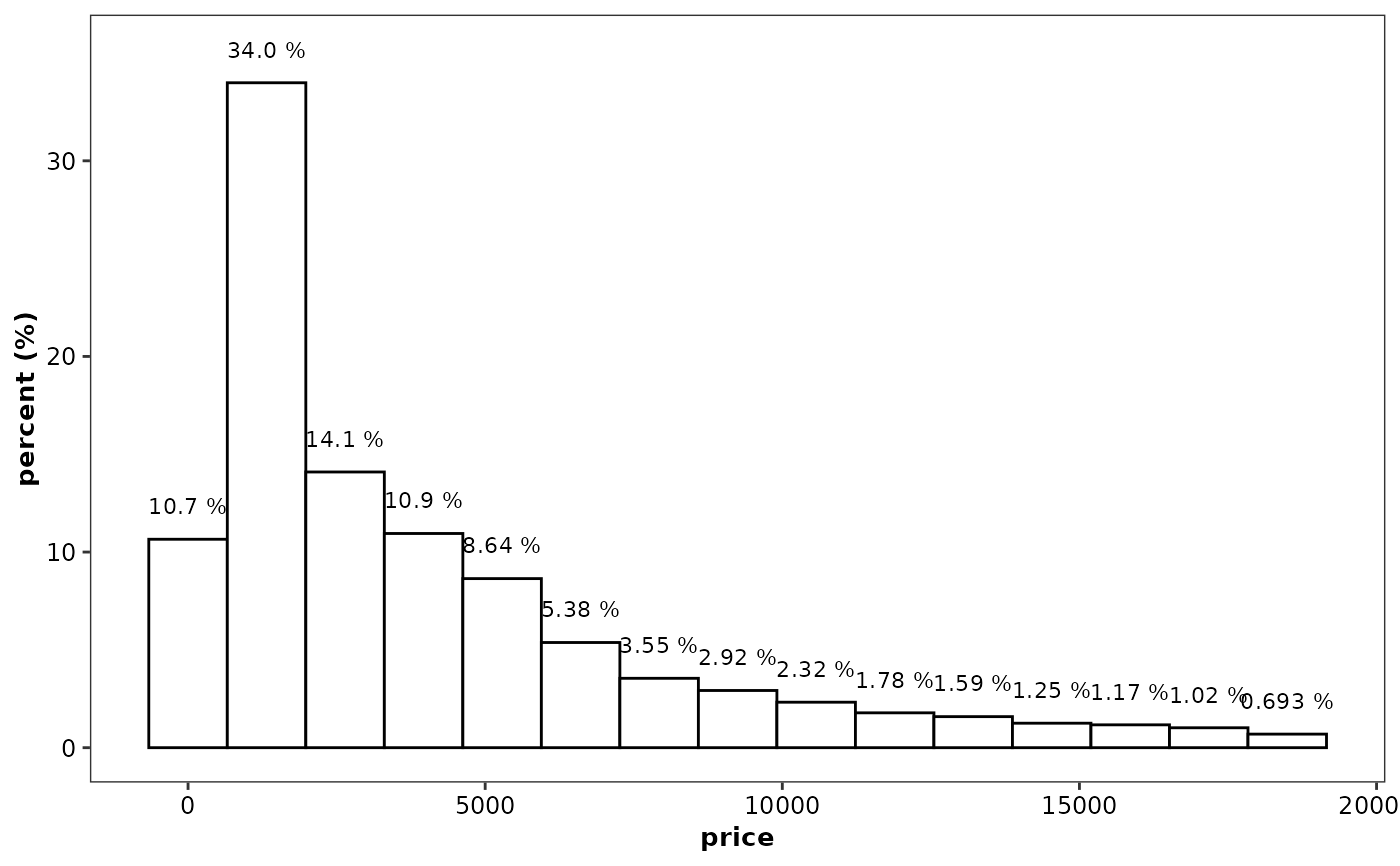This function is intended to work in combination with
geom_histogram to display the sum of the values
represented by each bar.
The same non-default arguments used in the the
geom_histogram call should also be used in the
geom_histcount call.
Density/percentage can be displayed by setting the y aesthetic to
after_stat(density / after_stat(percent) (which are provided by the
bin2 stat) and the label aesthetic to after_stat(density_label)
/ after_stat(percent_label) (which are provided by the histcount stat).
geom_histcount(
mapping = NULL,
data = NULL,
stat = "histcount",
position = "stack",
...,
digits = 3,
binwidth = NULL,
bins = NULL,
na.rm = FALSE,
orientation = NA,
show.legend = NA,
inherit.aes = TRUE
)
stat_histcount(
mapping = NULL,
data = NULL,
geom = "histcount",
position = "stack",
...,
digits = 3,
binwidth = NULL,
bins = NULL,
center = NULL,
boundary = NULL,
breaks = NULL,
closed = c("right", "left"),
pad = FALSE,
na.rm = FALSE,
orientation = NA,
show.legend = NA,
inherit.aes = TRUE
)Arguments
- mapping
Set of aesthetic mappings created by
aes(). If specified andinherit.aes = TRUE(the default), it is combined with the default mapping at the top level of the plot. You must supplymappingif there is no plot mapping.- data
The data to be displayed in this layer. There are three options:
If
NULL, the default, the data is inherited from the plot data as specified in the call toggplot().A
data.frame, or other object, will override the plot data. All objects will be fortified to produce a data frame. Seefortify()for which variables will be created.A
functionwill be called with a single argument, the plot data. The return value must be adata.frame, and will be used as the layer data. Afunctioncan be created from aformula(e.g.~ head(.x, 10)).- position
Position adjustment, either as a string naming the adjustment (e.g.
"jitter"to useposition_jitter), or the result of a call to a position adjustment function. Use the latter if you need to change the settings of the adjustment.- ...
Other arguments passed on to
layer(). These are often aesthetics, used to set an aesthetic to a fixed value, likecolour = "red"orsize = 3. They may also be parameters to the paired geom/stat.- digits
Integer indicating the number of significant digits to be used. Recognized values are
0..22. Usedigits = 0to display as integers.- binwidth
The width of the bins. Can be specified as a numeric value or as a function that calculates width from unscaled x. Here, "unscaled x" refers to the original x values in the data, before application of any scale transformation. When specifying a function along with a grouping structure, the function will be called once per group. The default is to use the number of bins in
bins, covering the range of the data. You should always override this value, exploring multiple widths to find the best to illustrate the stories in your data.The bin width of a date variable is the number of days in each time; the bin width of a time variable is the number of seconds.
- bins
Number of bins. Overridden by
binwidth. Defaults to 30.- na.rm
If
FALSE, the default, missing values are removed with a warning. IfTRUE, missing values are silently removed.- orientation
The orientation of the layer. The default (
NA) automatically determines the orientation from the aesthetic mapping. In the rare event that this fails it can be given explicitly by settingorientationto either"x"or"y". See the Orientation section for more detail.- show.legend
logical. Should this layer be included in the legends?
NA, the default, includes if any aesthetics are mapped.FALSEnever includes, andTRUEalways includes. It can also be a named logical vector to finely select the aesthetics to display.- inherit.aes
If
FALSE, overrides the default aesthetics, rather than combining with them. This is most useful for helper functions that define both data and aesthetics and shouldn't inherit behaviour from the default plot specification, e.g.borders().- geom, stat
Use to override the default connection between
geom_histcountandstat_histcount.- center, boundary
bin position specifiers. Only one,
centerorboundary, may be specified for a single plot.centerspecifies the center of one of the bins.boundaryspecifies the boundary between two bins. Note that if either is above or below the range of the data, things will be shifted by the appropriate integer multiple ofbinwidth. For example, to center on integers usebinwidth = 1andcenter = 0, even if0is outside the range of the data. Alternatively, this same alignment can be specified withbinwidth = 1andboundary = 0.5, even if0.5is outside the range of the data.- breaks
Alternatively, you can supply a numeric vector giving the bin boundaries. Overrides
binwidth,bins,center, andboundary.- closed
One of
"right"or"left"indicating whether right or left edges of bins are included in the bin.- pad
If
TRUE, adds empty bins at either end of x. This ensures frequency polygons touch 0. Defaults toFALSE.
Orientation
This geom treats each axis differently and, thus, can thus have two orientations. Often the orientation is easy to deduce from a combination of the given mappings and the types of positional scales in use. Thus, ggplot2 will by default try to guess which orientation the layer should have. Under rare circumstances, the orientation is ambiguous and guessing may fail. In that case the orientation can be specified directly using the orientation parameter, which can be either "x" or "y". The value gives the axis that the geom should run along, "x" being the default orientation you would expect for the geom.
Aesthetics
geom_histcount() understands the following aesthetics (required aesthetics are in bold):
xylabelalphaanglecolourfamilyfontfacegrouphjustlineheightsizevjust
Learn more about setting these aesthetics in vignette("ggplot2-specs").
See also
Examples
library(ggplot2)
p <- ggplot(diamonds)
# Histogram for continuous variable count
p +
aes(x = price) +
geom_histogram() +
geom_histcount()
#> `stat_bin()` using `bins = 30`. Pick better value with `binwidth`.
#> `stat_bin2()` using `bins = 30`. Pick better value with `binwidth`.
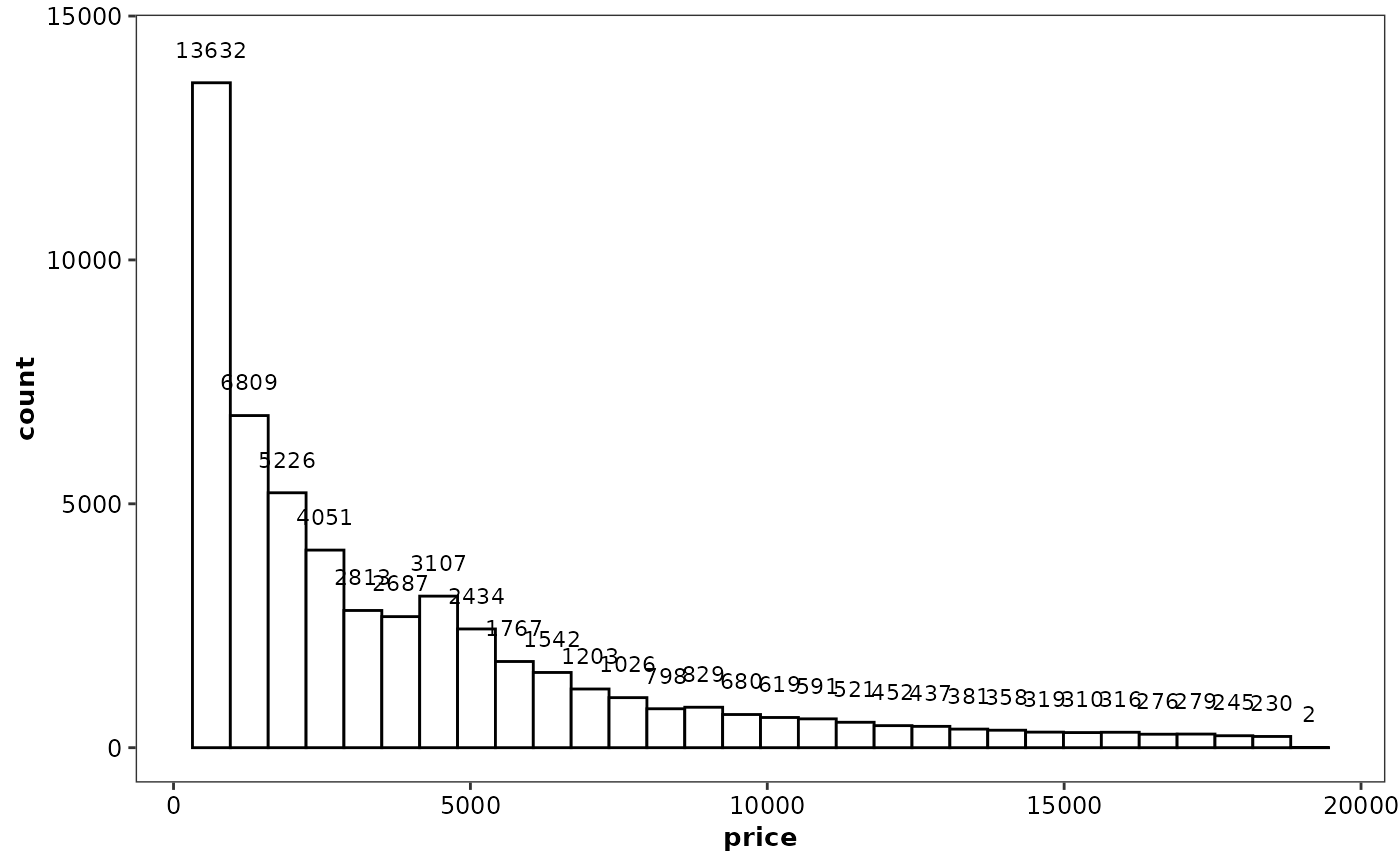 # Map class to y instead to flip the orientation
p +
aes(y = price) +
geom_histogram() +
geom_histcount()
#> `stat_bin()` using `bins = 30`. Pick better value with `binwidth`.
#> `stat_bin2()` using `bins = 30`. Pick better value with `binwidth`.
# Map class to y instead to flip the orientation
p +
aes(y = price) +
geom_histogram() +
geom_histcount()
#> `stat_bin()` using `bins = 30`. Pick better value with `binwidth`.
#> `stat_bin2()` using `bins = 30`. Pick better value with `binwidth`.
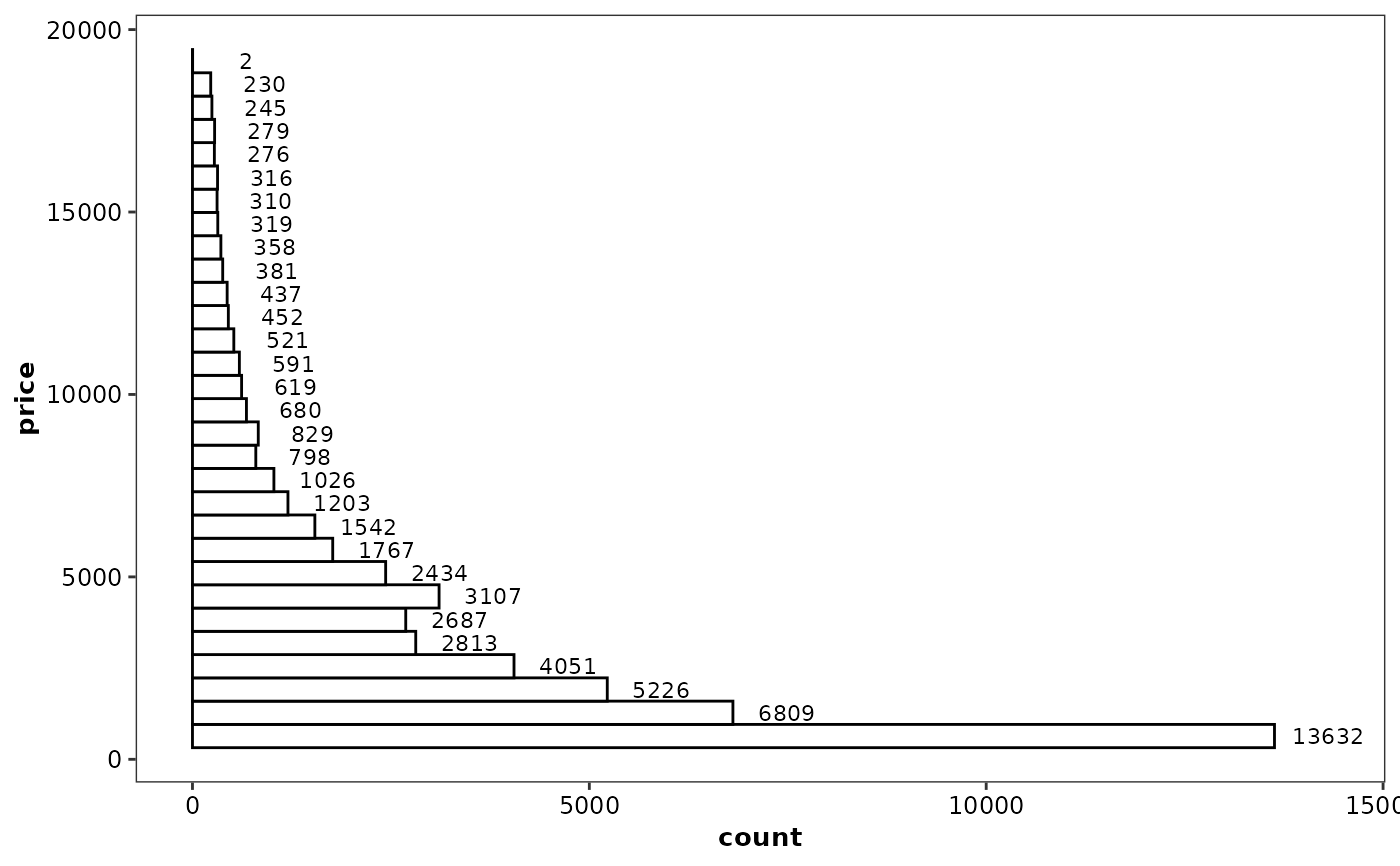 # Histogram with a fill aesthetic
p +
aes(x = price, fill = clarity) +
geom_histogram() +
geom_histcount()
#> `stat_bin()` using `bins = 30`. Pick better value with `binwidth`.
#> `stat_bin2()` using `bins = 30`. Pick better value with `binwidth`.
# Histogram with a fill aesthetic
p +
aes(x = price, fill = clarity) +
geom_histogram() +
geom_histcount()
#> `stat_bin()` using `bins = 30`. Pick better value with `binwidth`.
#> `stat_bin2()` using `bins = 30`. Pick better value with `binwidth`.
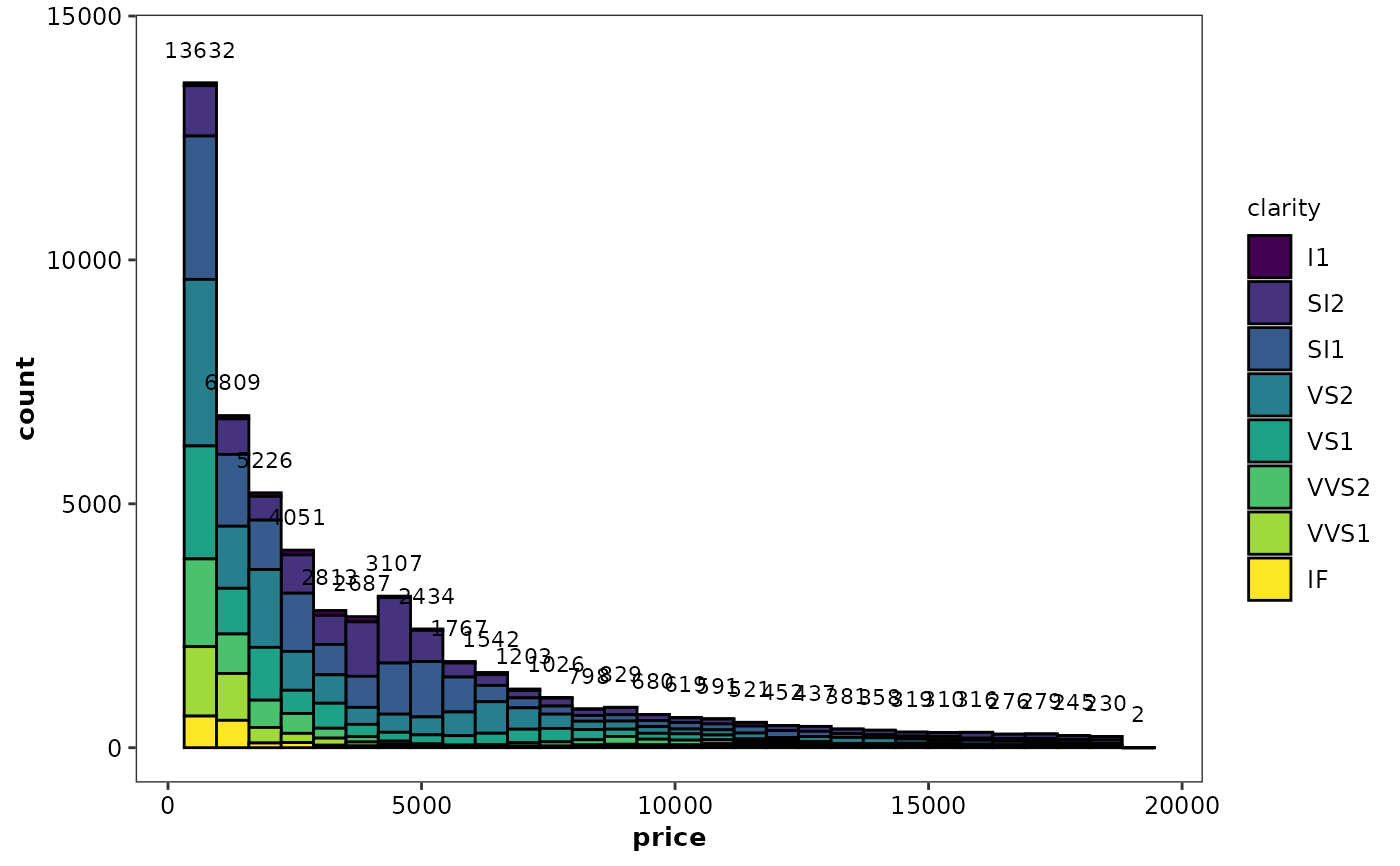 # Histogram for continuous variable density
p +
aes(x = price) +
geom_histogram(aes(y = after_stat(density)), stat = 'bin2', bins = 15) +
geom_histcount(aes(y = after_stat(density), label = after_stat(density_label)), bins = 15)
# Histogram for continuous variable density
p +
aes(x = price) +
geom_histogram(aes(y = after_stat(density)), stat = 'bin2', bins = 15) +
geom_histcount(aes(y = after_stat(density), label = after_stat(density_label)), bins = 15)
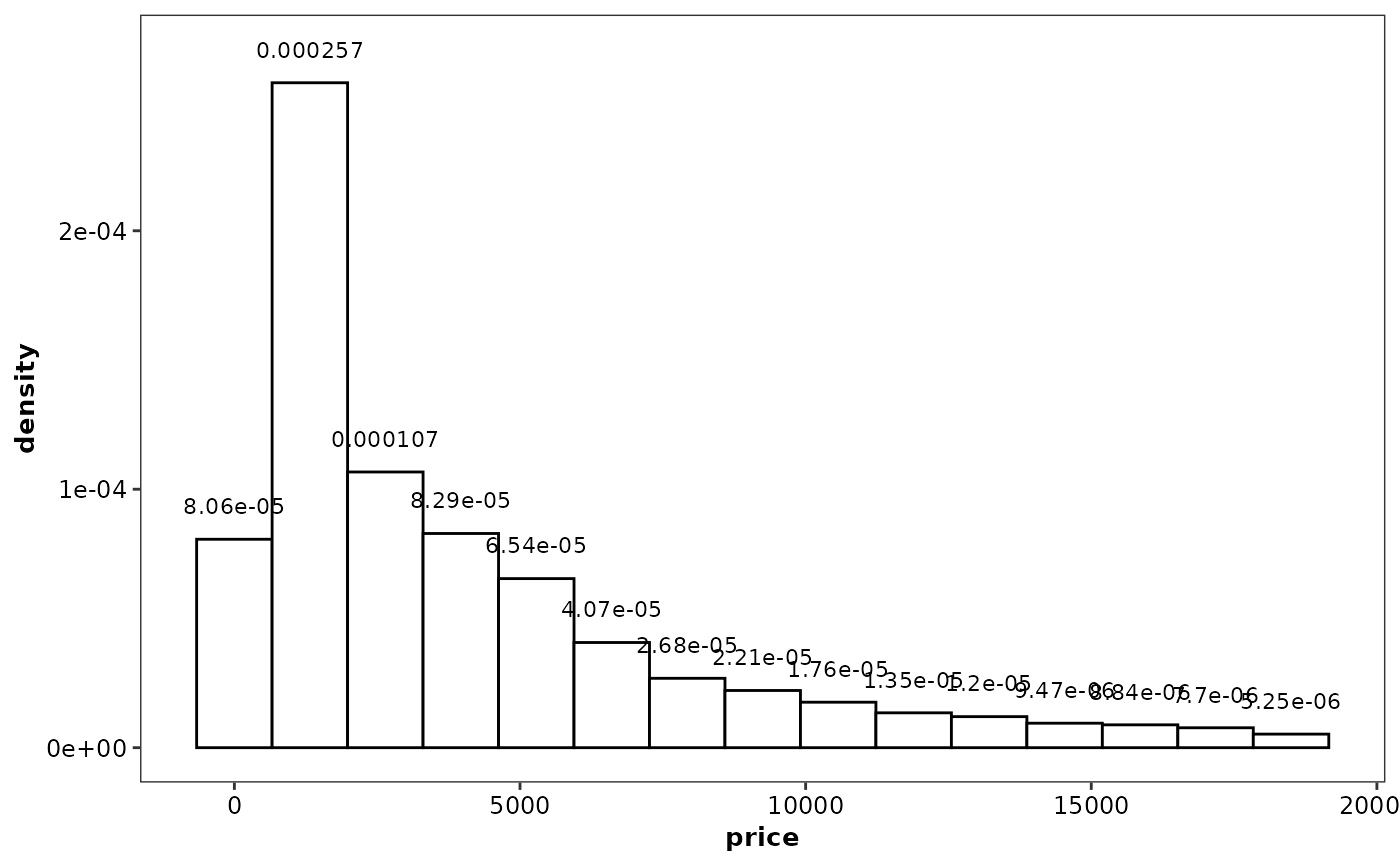 # Histogram for continuous variable percentage using the bin2 stat
p +
aes(x = price) +
geom_histogram(aes(y = after_stat(percent)), stat = 'bin2', bins = 15) +
geom_histcount(aes(y = after_stat(percent), label = after_stat(percent_label)), bins = 15) +
ylab('percent (%)')
# Histogram for continuous variable percentage using the bin2 stat
p +
aes(x = price) +
geom_histogram(aes(y = after_stat(percent)), stat = 'bin2', bins = 15) +
geom_histcount(aes(y = after_stat(percent), label = after_stat(percent_label)), bins = 15) +
ylab('percent (%)')
